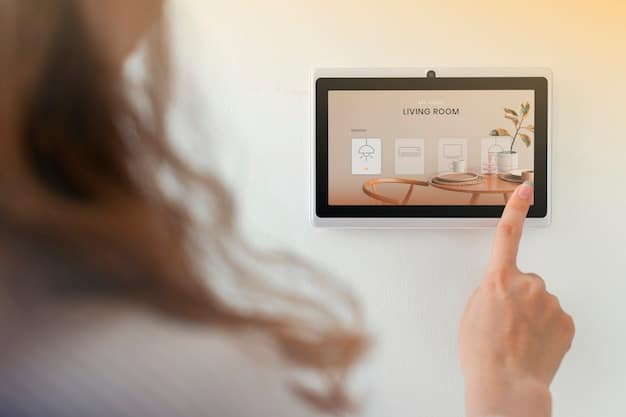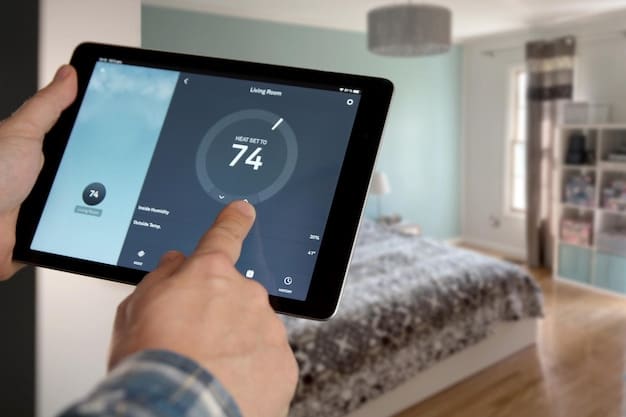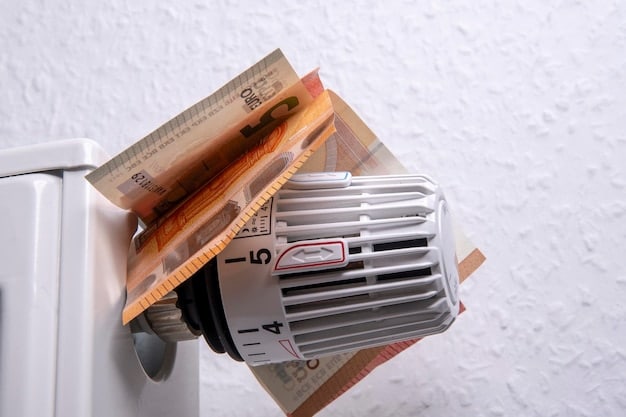Smart Thermostat Savings: Can You Really Save 15%?

Smart thermostats can offer potential savings on heating costs by automating temperature adjustments and optimizing energy usage, but the actual savings depend on several factors, including usage habits, home insulation, and local energy prices.
Can a smart thermostat really save you money on your heating bill? Many homeowners are curious about the potential smart thermostat savings: can you really save 15% on heating costs? Let’s delve into the factors that influence these savings and whether a smart thermostat is a worthwhile investment for your home.
Understanding Smart Thermostats and Their Functionality
Smart thermostats are sophisticated devices designed to regulate your home’s temperature efficiently. They go beyond traditional thermostats by offering programmable schedules, remote control, and often learning capabilities. Here’s a closer look at how they work.
Key Features of Smart Thermostats
Smart thermostats come packed with features that make them more than just temperature regulators. These features work together to help you save energy and manage your home’s heating and cooling more effectively.
- Programmable Schedules: Set different temperatures for different times of the day or week to match your routine.
- Remote Control: Adjust your thermostat from anywhere using a smartphone app.
- Learning Capabilities: Some models learn your habits and automatically adjust the temperature accordingly.
- Energy Reports: Track your energy usage over time to identify areas for improvement.
The combination of these features ensures that your home is only heated or cooled when necessary, reducing energy waste and optimizing your energy consumption.

How Smart Thermostats Learn Your Habits
One of the most innovative aspects of smart thermostats is their ability to learn your habits. These devices use sensors and algorithms to understand when you’re home, when you’re asleep, and when you’re away. Over time, they can automatically adjust the temperature based on your patterns.
For example, if you consistently lower the thermostat before going to bed, a learning thermostat will eventually automate this process. Similarly, if you’re usually away from home during the day, the thermostat will set a lower temperature to save energy. This automation ensures that you’re not wasting energy heating an empty house.
In conclusion, smart thermostats provide a multifaceted approach to energy management, combining programmable settings with intelligent learning capabilities to optimize your home’s temperature and reduce energy consumption.
The Claim: Can You Really Save 15% on Heating Costs?
Many smart thermostat manufacturers advertise potential savings of up to 15% on heating costs. But how realistic is this claim? The actual savings can vary considerably based on a number of factors.
Factors Influencing Heating Cost Savings
Several elements affect the extent to which a smart thermostat can reduce your heating bill. Understanding these factors is crucial for setting realistic expectations and maximizing potential savings.
- Home Insulation: Poorly insulated homes lose heat more quickly, requiring more energy to maintain a consistent temperature.
- Usage Habits: How often you adjust the temperature and your typical heating patterns significantly impact savings.
- Local Energy Prices: The cost of energy in your area affects the monetary value of the savings.
- Thermostat Model: Different models have varying levels of efficiency and features that can influence energy consumption.
These factors interact to determine the overall impact of a smart thermostat on your heating costs. For example, a well-insulated home with consistent heating patterns is likely to see more significant savings than a poorly insulated home with frequent temperature adjustments.
Evidence from Studies and User Experiences
While some studies support the claim of 15% savings, others indicate more modest reductions. User experiences also vary widely, with some homeowners reporting substantial savings and others seeing minimal impact.
Some studies have shown that programmable thermostats, including smart thermostats, can save around 10-12% on heating and cooling costs. However, these studies often assume optimal usage, which may not reflect real-world scenarios. User reviews frequently mention savings ranging from 5% to 20%, depending on individual circumstances and energy habits.

Ultimately, the 15% claim should be viewed as an estimate rather than a guarantee. While smart thermostats can certainly help reduce heating costs, the actual savings depend on a complex interplay of factors.
In conclusion, while a 15% reduction in heating costs is possible, it’s essential to consider the specific conditions of your home and energy habits to set realistic expectations for potential savings.
Calculating Your Potential Savings
Estimating the potential savings from a smart thermostat involves considering your current energy consumption, local energy prices, and the efficiency of your home’s heating system. Here’s a step-by-step guide to help you calculate your potential savings.
Assess Your Current Energy Consumption
Start by reviewing your past energy bills to understand your current heating costs. Look for monthly or seasonal trends to identify periods of high energy consumption.
Calculate your average monthly heating cost by summing up your heating expenses over the past year and dividing by twelve. Also, analyze your energy usage during the peak heating season to get a sense of your maximum heating costs. This baseline information will help you gauge the impact of a smart thermostat on your energy bill.
Factor in Local Energy Prices
Energy prices vary by location, so it’s important to use accurate data for your area. Check your energy bills or contact your local utility company to find out the current price per unit of energy (e.g., kilowatt-hour or therm).
- Visit your local utility company’s website.
- Check government energy websites for regional pricing.
- Use online tools to estimate energy costs based on your location and consumption.
Understanding your local energy prices is crucial for translating energy savings into monetary savings. For example, a 10% reduction in energy consumption will result in greater savings in an area with high energy prices compared to an area with low prices.
Use Online Savings Calculators
Several online tools and calculators can help you estimate the potential savings from a smart thermostat. These calculators typically ask for information about your location, home size, heating system, and current energy consumption.
These calculators provide a rough estimate of the potential savings, but keep in mind that the actual savings may vary based on your individual circumstances.
By assessing your current energy consumption, factoring in local energy prices, and using online savings calculators, you can develop a more accurate estimate of the potential savings from a smart thermostat.
Maximizing Savings with Smart Thermostats
To achieve the maximum possible savings with a smart thermostat, it’s crucial to optimize its settings and integrate it with other energy-efficient practices. Here are some strategies to help you get the most out of your smart thermostat.
Smart Scheduling Strategies
Creating a smart schedule is essential for maximizing energy savings. Think about your daily and weekly routines to identify opportunities to lower the temperature when you’re away or asleep.
Set different temperatures for weekdays and weekends to reflect your varying routines. Use time-of-day scheduling to lower the temperature during the night and when you’re at work or school. Also, take advantage of vacation mode to set a lower temperature when you’re away for extended periods. This will help to reduce energy consumption.
Integrating with Other Home Automation Systems
Smart thermostats can often be integrated with other home automation systems, such as smart lights and smart window shades. This integration can further enhance your energy savings.
- Smart Lighting: Integrate your thermostat with smart lights to automatically dim or turn off lights when you leave a room.
- Smart Window Shades: Use smart window shades to block sunlight during the hottest part of the day, reducing the need for air conditioning.
- Voice Assistants: Connect your thermostat to voice assistants like Amazon Alexa or Google Assistant for hands-free control.
By integrating your smart thermostat with other home automation systems, you can create a comprehensive energy management strategy that optimizes your home’s energy consumption.
Regular Maintenance and Updates
Like any other electronic device, smart thermostats require regular maintenance and updates to ensure optimal performance. This includes cleaning the device, checking the battery, and installing firmware updates.
Make sure to clean the thermostat regularly to remove dust and debris that could affect its accuracy. Replace the batteries as needed to prevent disruptions in its operation. Also, install the latest firmware updates to ensure that your thermostat has the most up-to-date features and improvements.
By following these strategies, you can maximize the savings and benefits of your smart thermostat, creating a more energy-efficient and comfortable home.
Potential Drawbacks and Considerations
While smart thermostats offer numerous benefits, there are also potential drawbacks and considerations to keep in mind. Understanding these factors can help you make an informed decision about whether a smart thermostat is right for you.
Upfront Costs and Installation
The upfront cost of a smart thermostat can be higher than that of a traditional thermostat. Installation can also be a factor, especially if you need to hire a professional.
The initial investment may be a barrier for some homeowners. Professional installation can add to the cost, particularly if your home’s wiring is not compatible with the thermostat. Consider the potential savings over time to determine if the upfront investment is worthwhile. Also consider DIY installation.
Compatibility Issues
Not all smart thermostats are compatible with all heating and cooling systems. It’s important to check compatibility before making a purchase.
- Wiring Requirements: Some thermostats require specific wiring configurations that may not be present in older homes.
- System Types: Certain thermostats may not be compatible with all types of heating and cooling systems, such as heat pumps or radiant heating.
Checking compatibility can prevent frustration and ensure that the thermostat will work effectively with your existing system.
Privacy and Security Concerns
As with any connected device, there are privacy and security concerns associated with smart thermostats. These devices collect data about your usage patterns and temperature preferences, which could potentially be vulnerable to hacking or misuse.
Choose thermostats from reputable brands with strong security features, such as encryption and two-factor authentication. Review the privacy policies of the thermostat manufacturer to understand how your data is collected and used. Take steps to secure your home network to prevent unauthorized access to your smart devices.
Assessing these drawbacks and considerations can help you make an informed decision about whether a smart thermostat is the right choice for your home. By weighing the potential benefits against the potential risks, you can determine if a smart thermostat is a worthwhile investment for your energy-saving goals.
Choosing the Right Smart Thermostat
Selecting the right smart thermostat for your home involves considering various factors, including compatibility, features, and budget. Here’s a guide to help you navigate the options and choose the thermostat that best meets your needs.
Evaluating Key Features
Different smart thermostats offer different features, so it’s important to identify the features that are most important to you. For example, some thermostats have advanced learning capabilities, while others offer more basic scheduling options.
Consider whether you want a thermostat with learning capabilities, remote control, energy reports, or integration with other smart home devices. Also, think about the user interface and ease of use to ensure that the thermostat is easy to program and control.
Considering Compatibility with Your HVAC System
Before making a purchase, it’s crucial to ensure that the smart thermostat is compatible with your home’s heating, ventilation, and air conditioning (HVAC) system. Check the thermostat’s specifications to confirm that it supports your system type and wiring configuration.
- System Type: Verify that the thermostat is compatible with your system, such as forced air, heat pump, or radiant heating.
- Wiring Requirements: Check the wiring requirements to ensure that your home’s wiring is compatible with the thermostat.
Ensuring compatibility can prevent installation issues and ensure that the thermostat works effectively with your HVAC system.
Budget and Long-Term Value
Smart thermostats range in price from around $100 to $300 or more. Consider your budget and weigh the upfront cost against the potential long-term savings in energy costs.
While a more expensive thermostat may offer more features, it may not necessarily result in greater energy savings. Evaluate the long-term value of the thermostat by considering its energy efficiency, durability, and potential savings in energy costs over time.
By evaluating key features, considering compatibility with your HVAC system, and assessing your budget and long-term savings, you can choose the right smart thermostat for your home. This will help you maximize your energy savings and create a more comfortable and energy-efficient living environment.
| Key Point | Brief Description |
|---|---|
| 💡 Smart Features | Automated schedules, remote control. |
| 💰 Savings | Dependent upon insulation, energy usage. |
| 🏡 Compatibility | Check before purchase for system compatibility. |
| 🔒 Security | Secure network and choose reputable brands. |
FAQ Section
▼
Smart thermostats use sensors and algorithms to monitor your temperature adjustments and occupancy patterns. Over time, they identify trends and automatically adjust the temperature to match your routine, optimizing energy usage without manual input.
▼
Yes, most smart thermostats come with a smartphone app that allows you to control the temperature from anywhere with an internet connection. This feature is useful if you forget to adjust the thermostat before leaving home.
▼
A smart thermostat can still help, but you might not see the full 15% savings. Improving insulation will further enhance energy efficiency, allowing the thermostat to maintain stable temperatures with less energy consumption, maximizing savings.
▼
Reputable brands employ encryption and security protocols to protect your data. Regularly update the thermostat’s firmware and secure your home Wi-Fi network. Review the manufacturer’s privacy policies for details on data handling practices.
▼
Check the thermostat’s product specifications or the manufacturer’s website for a compatibility checker. Otherwise, consult with a professional HVAC technician to verify that the thermostat is compatible with your specific heating and cooling system.
Conclusion
In conclusion, while smart thermostat savings: can you really save 15% on heating costs? The answer is not always straightforward. While the 15% savings claim can be realistic, it’s more important to consider a holistic approach to energy efficiency that includes optimizing energy usage and home insulation. The technology will help you be more aware of your energy consumption to help make better decisions.





